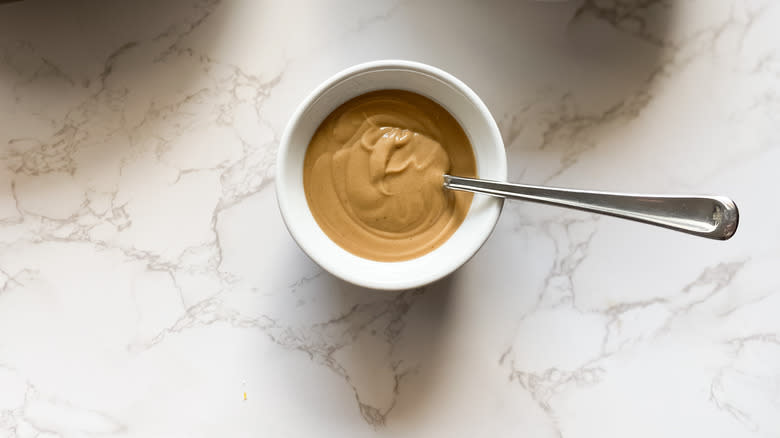Patience Is Key To Making Thai Peanut Sauce

Many condiments add little to a dish other than flavor, which is, after all, their whole point and purpose. Still, there are a few sauces that have something extra to offer, such as a Thai-style peanut sauce which can serve as a much-needed source of protein for vegan meals. Peanut sauce need not be reserved for plant-based meals alone, as it also tastes great as a dip for satay chicken skewers.
While some folks might think of Thai food as being pretty spicy, Mashed developer Kristen Carli has come up with a Thai peanut sauce recipe that's really quite mild since its main ingredients are peanut butter, rice vinegar, sesame oil, and soy sauce. There's only a smidgen of sriracha to bring a faint hint of heat. If you want it hotter, though, you can always add more sriracha or stir in some crushed red pepper.
Carli's peanut sauce requires no cooking, but it'll take quite a bit of stirring to get the peanut butter to combine with the liquids. As Carli says right in the recipe directions, "[The] mixture will appear to not combine, but with patience, [it] will eventually come together." As a bonus, your arm will get a mini-workout in the process.
Read more: 7 Nuts You Should Be Eating And 7 You Shouldn't
What To Do If Your Peanut Butter Is Too Dry Or Thick To Stir

While Carli's directions will work if your peanut butter's soft and stirrable, you might run into difficulties if it's not. If you're getting to the bottom of the jar and it's starting to dry out or you've bought the all-natural kind that's separated into a dense sludge with an oil slick on top, heat might help soften it so you can stir. If your jar is glass, you can heat it in a pan of water on the stovetop. People might recommend sticking a plastic one in the microwave for a few seconds. However, brands like Skippy explicitly advise against microwaving the jar.Yet another step to loosen up your peanut butter is to mix in some oil that, in the case of the all-natural kind, might be already present on top. If you need to add oil, choose a neutral-tasting one like canola or vegetable. Olive oil might make it taste weird. Should the peanut butter be too stiff to stir in the oil, a handheld mixer can help with the emulsification. You can use a mixer to blend your Thai peanut sauce, too. Give the whisk a rest and bring out the big guns — er, appliances — to power through this step, since a blender or food processor will work, too. Your sauce should be as smooth and tasty as if you'd stirred it by hand, but your arm will be a lot less tired.
Read the original article on Mashed.


